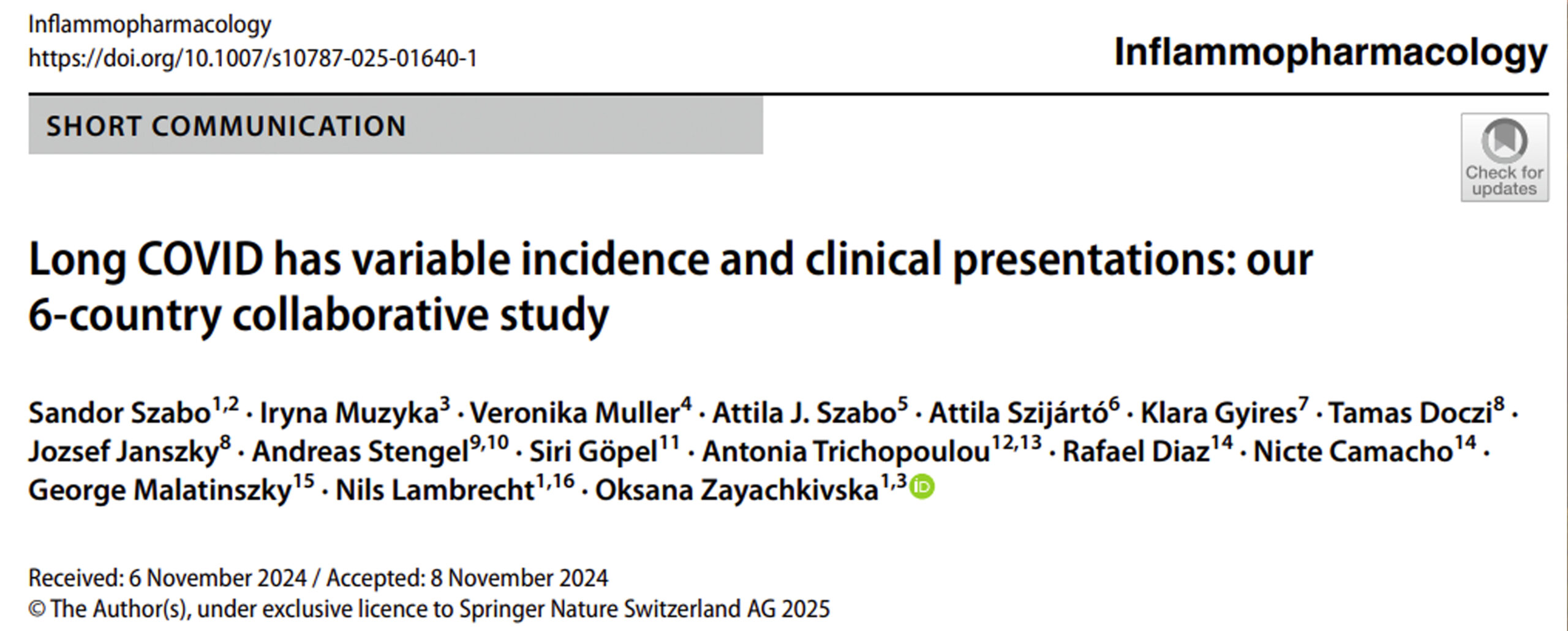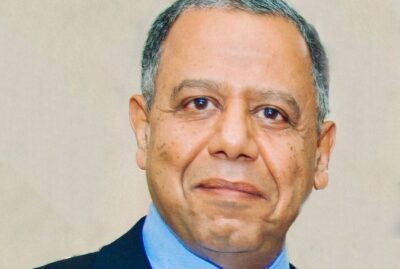An International Study on Long COVID Designed by and Coordinated From AUHS-SOM: Results Have Just Been Published!
By Sandor Szabo, MD, PhD, MPH, Professor & Dean, School of Medicine
Long COVID is a prolonged, lingering chronic form of acute COVID-19 disease that affects about 10-20% of surviving patients, although the prevalence and incidence of Long COVID vary from country to country (1). Some of us with a public health background and research interest have been fascinated by the sudden explosion of the COVID-19 pandemic that created panic, confusion, and stress from the very beginning in 2019 and 2020 (2). But fascination is not enough to advance our understanding and knowledge about a new disease. Thus, a few of us in the AUHS-SOM, especially Drs. N. Lambrecht, P. Zourna, and J. Schloss, subsequently Dr. O. Zayachkivska, started planning and designing a large international collaborative study to better understand the manifestations and incidence of Long COVID around the world.
 Since we have professional contacts in many countries, we initially were planning to involve 10 countries, e.g., 4 from Europe, 2 from Africa, 2 from Asia, in addition to the USA and Mexico. Based on this initial study design, we submitted 2 grant applications to the CDC and one to USAID. None of these grant applications were rejected on scientific grounds; they were tentatively approved for potential funding, but the funding never came. This could have been the end of any collaborative study, but not for us, who have experience not only in basic, but also clinical research. Thus, we scaled down our specific aims and focused only on three goals:
Since we have professional contacts in many countries, we initially were planning to involve 10 countries, e.g., 4 from Europe, 2 from Africa, 2 from Asia, in addition to the USA and Mexico. Based on this initial study design, we submitted 2 grant applications to the CDC and one to USAID. None of these grant applications were rejected on scientific grounds; they were tentatively approved for potential funding, but the funding never came. This could have been the end of any collaborative study, but not for us, who have experience not only in basic, but also clinical research. Thus, we scaled down our specific aims and focused only on three goals:
- Establish the incidence (i.e., number of new cases) in a year at selected, representative hospitals and clinics in 6 countries (i.e., Germany, Greece, Hungary and Ukraine, USA, and Mexico)
- Collect and compare the presenting (objective) signs and (subjective) symptoms of Long COVID patients.
- Collect abnormal laboratory results that these patients demonstrate at admission and during hospitalizations, if applicable.
The latest point was the most challenging to implement without any extramural funding. Nevertheless, we managed to convince our international collaborators to incorporate laboratory results that might be part of their institutions’ initial diagnostic and treatment protocols/plans.
The results of our study were in the February issue of a top international (group quality 1) journal, Inflammopharmacology (3):
Our main published conclusions are as follows:
- Long COVID is a multi-organ inflammatory chronic condition of variable intensity and incidence,
partly due to the retention of the virus or viral particles in several organs.
- We found that the incidence of Long COVID varied from 46% (Mexico) to 17%
(Ukraine), the average being 25%.
- In a summary evaluation of all 6 countries, we characterized as “general” the most frequent
presenting signs and symptoms: fatigue (47%), hair loss (39.2%), and myalgia (35%), but no two countries demonstrated the same top 3 clinical signs/symptoms.
- Hence, we promote the following 3 key points: 1. to expand international collaborations
to better understand not only the prevalence and incidence of Long COVID but also to gain insights into the pathogenesis, and identify predisposing factors and diagnostic biomarkers of Long COVID; 2. find or develop new drugs for the treatment of Long COVID and identify appropriate rehabilitation, potentially organ-specific strategies; 3. most importantly, to start long-term observational studies (e.g., for 5–10–15 years) to identify potential increased cancer incidence in any organ, especially, since we know that certain viruses are carcinogens.
These results are illustrated in the following figures of our publication (3):
The most frequent laboratory abnormalities were elevated levels of blood C-reactive protein (CRP), D-dimer, and white blood cells.
We need to add that this (3) is not the only publication our AUHS-SOM research team produced during the last few years, e.g., Dr. John Schloss published interesting reviews of nutritional factors predisposing to COVID-19 (4, 5); Dr. Oksana Zayachkivska and her Ukrainian collaborators analyzed the physiological predisposing factors to Long COVID (6), and I pointed out that the recently established post-COVID stress syndrome is identical to the three-stage stress response, originally described by Hans Selye (7). Furthermore, special compliments are due to Natalia Kulchytska and Dr. Oksana Zayachkivska for the design of illustrations and their final analysis of the collected international results.
Thus, although substantial extramural grants are usually essential for basic and clinical investigations, our just-published, 6-country collaborative study indicates that substantial new results about the manifestation and public health implications of a disease can be obtained by a clever and modest, multicenter study design.
References:
- Szabo S, Zayachkivska O, Hussain A, Muller V. What is really “Long COVID”? Inflammopharmacology, 2023, 31:551–557. https://doi. org/10.1007/s10787-023-01194-0 –557. https://doi.org/10.1007/s10787-023-01194-0
- Szabo S (2020) COVID-19: new disease and chaos with panic, associated with stress. Med Sci, 2020, 59:41–62. https://doi.org/10.25040/ntsh2020.01.14
- Szabo S., Lambrecht N., Zayachkivska O. et al. Long COVID has variable incidence and clinical presentations – our 6‑country collaborative study. Inflammopharmacology, Published online 21 February 2025, https://doi.org/10.1007/s10787-025-01640-1
- Schloss J. Nutritional deficiencies that may predispose to long COVID. Inflammopharmacology, 2023, 31:573–583. https://doi.org/10.1007/s10787-023-01183-3S
- Karkhut S-M, Muzyka I, Savytska M, Dzhyoieva K, Pohoretska Y, Ivanchenko N, Zayachkivska O, Schloss JV, Szabo S. Physiological predictors of long-term effects of COVID-19 in patients with SARS-COV-2: focus on lymphocyte proliferation-improving micronutrients. Med Sci. 2021, 12;65(2). https://doi.org/10.25040/ntsh2021.02.06
- Muzyka I, Yakhnytska M, Savytska M, Zayachkivska O. Long COVID prevalence and physiology-centered risks: population-based study in Ukraine. Inflammopharmacology, 2023, 31:597–602. https://doi.org/10.1007/s10787-023-01177-1
- Szabo S. The post-COVID stress syndrome: from the three-stage stress response of Hans Selye to COVID-19. Inflammopharmacology, 2023, 31:2799–2806. https://doi.org/10.1007/s10787-023-01179-z

















